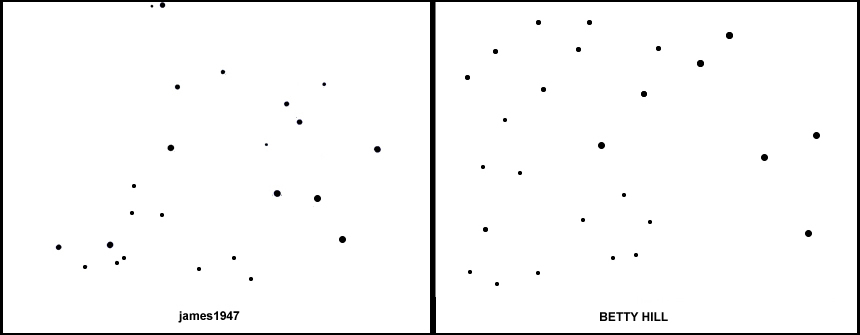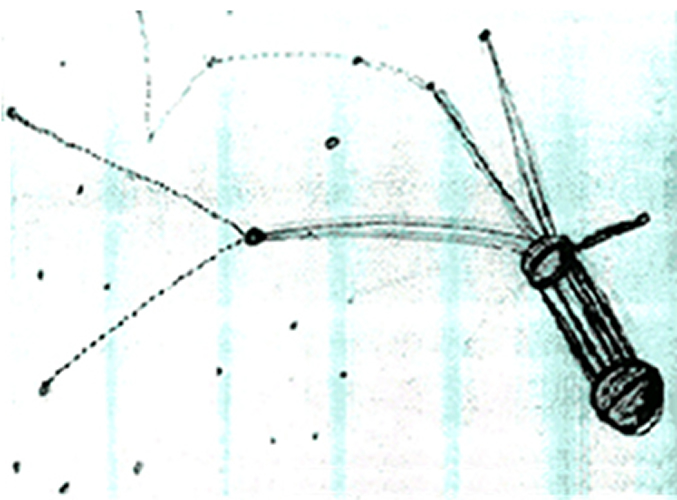It looks like you're using an Ad Blocker.
Please white-list or disable AboveTopSecret.com in your ad-blocking tool.
Thank you.
Some features of ATS will be disabled while you continue to use an ad-blocker.
share:
originally posted by: Ectoplasm8
a reply to: andre18
First off, the map I drew was specifically related to this incident and not just a set of random points for a reason. It shows where the Hills lived and where their claimed abduction happened.
Yet, it is wholly irrelevant to the discussion.
I have however used a random dot generator under one of his other usernames to show random points can be created then lines connected to make a map similar to Betty's. He believes his template excuse gives him leeway to do anything with the dots as long it's a match in a general and basic way.
Again, such a task is irrelevant because you never match your "dots" to actual stars, and probably wouldn't be able to.
Here is Betty's map side by side with james1947 with the suggestive lines removed:
Do you see a close match?
Actually, yes, but, I'll show you how/why in a later post.
Here is an actual overlay of james1947 (white dots) map onto Betty's (red dots) map with Zeta Reticuli 1 being aligned with both and the background black:
Do you see a close match yet? Do you see something to get excited about?
Are you aware that you have your colors reversed? Those "Red" dots are mine. lol
Next, Betty describes in her account that solid trade routes go from planet to planet:
PDF The Hill Report page 9
The heavy black lines indicated trade routes between planets; some of these went from one planet to another in a series of lines. Light lines were routes to planets or stars occasionally visited. Broken lines were expeditions or exploration trips to distant bodies.
Now look at Betty's map and tell me which dots have heavy black lines drawn to them:
-- from the same PDF as yours, later in the document
He went over to the wall and pulled down a map, strange to me. Now I would believe this to be sky map. It was a map of the heavens, with numerous size stars and planets, some large, some only pinpoints. Between many of these,lines were drawn, some broken lines, some light solflfl lines, some hearvy black lines. They were not straight, but curved. Some went from one planet to another, to a.-other, in a series nf lir.es.
Okay; so either ET is a complete klutz when it comes to Graphical User Interfaces/Displays, or Betty was mistaken about the "stars and planets" being on the same display as YOU want it to be. I'm sorry man, but, that is just plain poor GUI design...period!
And, I don't buy that ET is that stupid, considering he seems to have solved that FTL thing and all. Do you think ET is that stupid? Apparently!
Has SETI ever discovered a signal received from this part of our galaxy?
That's rich, I really like that question...Seriously!
You do realize, I hope, that no signal that can be received, that might remotely be artificial, can be more than 5 or so light years from Earth, right? Think about this: Power(received) = Power(transmitted)/distance^2. That will be power in watts, and distance in meters; have fun.
Do we have any supporting evidence in the last 50+ years that intelligent life has occurred there?
Well, not in the past 50, but in the past 60; yes...I'm trying to relate that to you.
These are only a few logical question to ask of this case in which james1947 wants to dismiss and distance himself from.
What is it I trying to distance myself from, again? Oh, that's right; the freakin' noise! By filtering some of the noise, the signal-to-noise ratio can be improved.
It also helps his own claim of decades-long abductions in which he has no evidence.
Well that is unnecessarily hurtful! Perhaps IF you had had an abduction experience, you might be more Human. You probably can't relate to this, but, I don't care! Your statement is kind of like being spat at when returning from Vietnam.
edit on 6-3-2019 by james1947 because: (no reason given)
Here is a continuance of the original PDF. This shows the early work done to determine IF a match was even plausible, as you will see this line of
inquiry paid off rather well.
Manual Template Matching
13 identified Stars
Marjorie Fish identified 13 primary stars that conformed to the template provided by Betty Hill.
1. Zeta (1) Reticuli
2. Zeta (2) Reticuli
3. Alpha Mensae
4. 82 Eridani
5. Tau Ceti
6. Sol
7. 107 Piscis
8. 54 Piscis
9. Gliese 67 Hip 7918
10. Gliese 86 Hip 10138
11. Tau (1) Eridani
12. Gliese 59A Hip 7235
13. Kappa Fornascis
The remainder of the stars are identified here:
14. HIP 22451
15. Upsilon Andromeda
16. Phi (2) Ceti
17. HIP 113421*
18. HIP 101933*
19. HIP 114703*
20. HIP 111170
21. HIP 102203*
22. HIP 101345
23. Xi(2) Capricorni
24. HIP 7978
25. Chi Eridani
26. HIP 26737 (the POV, not drawn on map, and outside search area)
(* unknown prior to 1992)
7 groups (blobs)
The original template seemed to lend itself rather well to the definition of seven (7) distinct groups or blobs.
i. The Square Root symbol. This group of stars resembles the mathematical Square Root symbol. I have included the single star of Group 3 in this because they do make for a “whole idea”
ii. The Greater than Sign. This structure resembles the mathematical “Greater Than” sign.
Note: blob 1 and 2 are the most significant aspects of the “blob” analytics. When taken with blob 3 it begins to form a sort of mathematical expression (“Triangle” > SQRT(“lonestar”) ). This “formation” affords us a valuable tool in evaluating possible matches.
iii. Our only single star group. It serves as a method to identify the specific “square root” symbol. When viewed in conjunction with blobs 1 and 2, this feature helps to form an unexpected feature to assist in the identifying process.
iv. The Triangle. A group of three stars forming a sort of triangle within the “Greater Than” sign.
v. The boomerang, this grouping of stars serves to further identify the “Grater Than” sign.
vi. This group of 3 stars that form a union with group 1 seems rather cramped, perhaps by the size of the page at original drawing time. In any case they help to identify the terminus of the Square Root symbol.
vii. The pentagon. This collection of 5 stars form a rough pentagram and help to identify the whole.
viii. The binary pair. While not shown in the “graphic” the host star is depicted as two “joined” stars; logic strongly suggests a binary star.
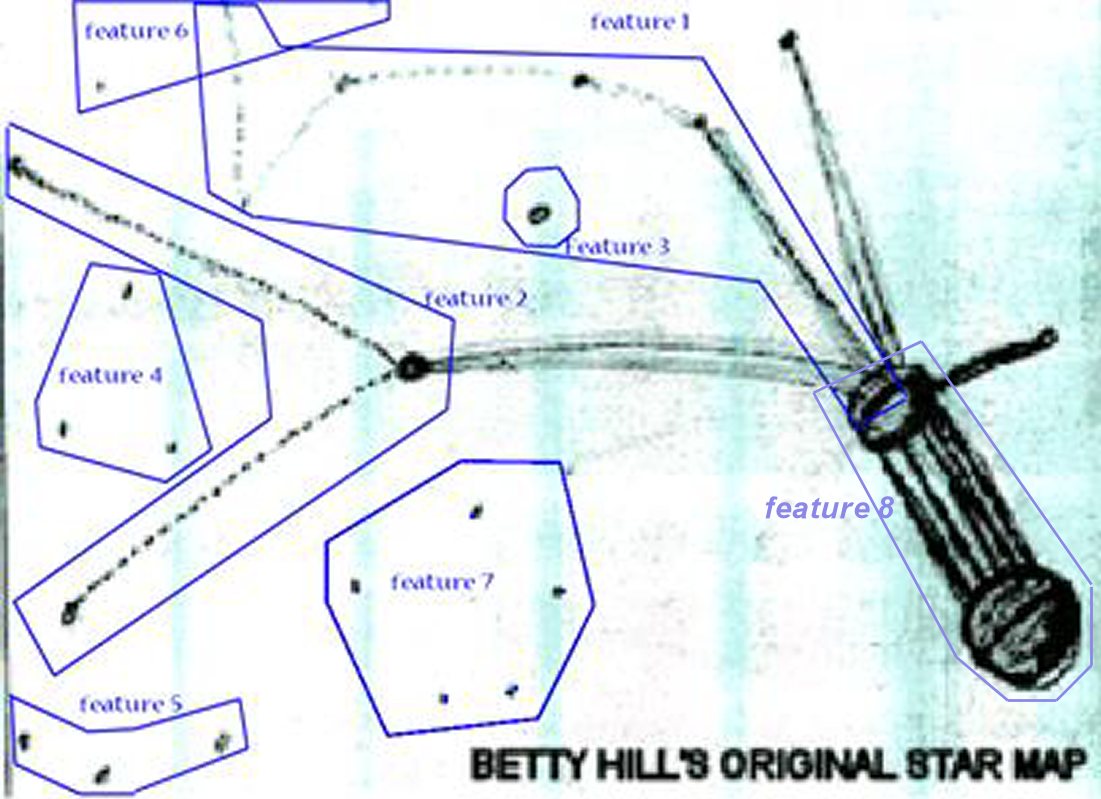
3 Break down of Template Objects
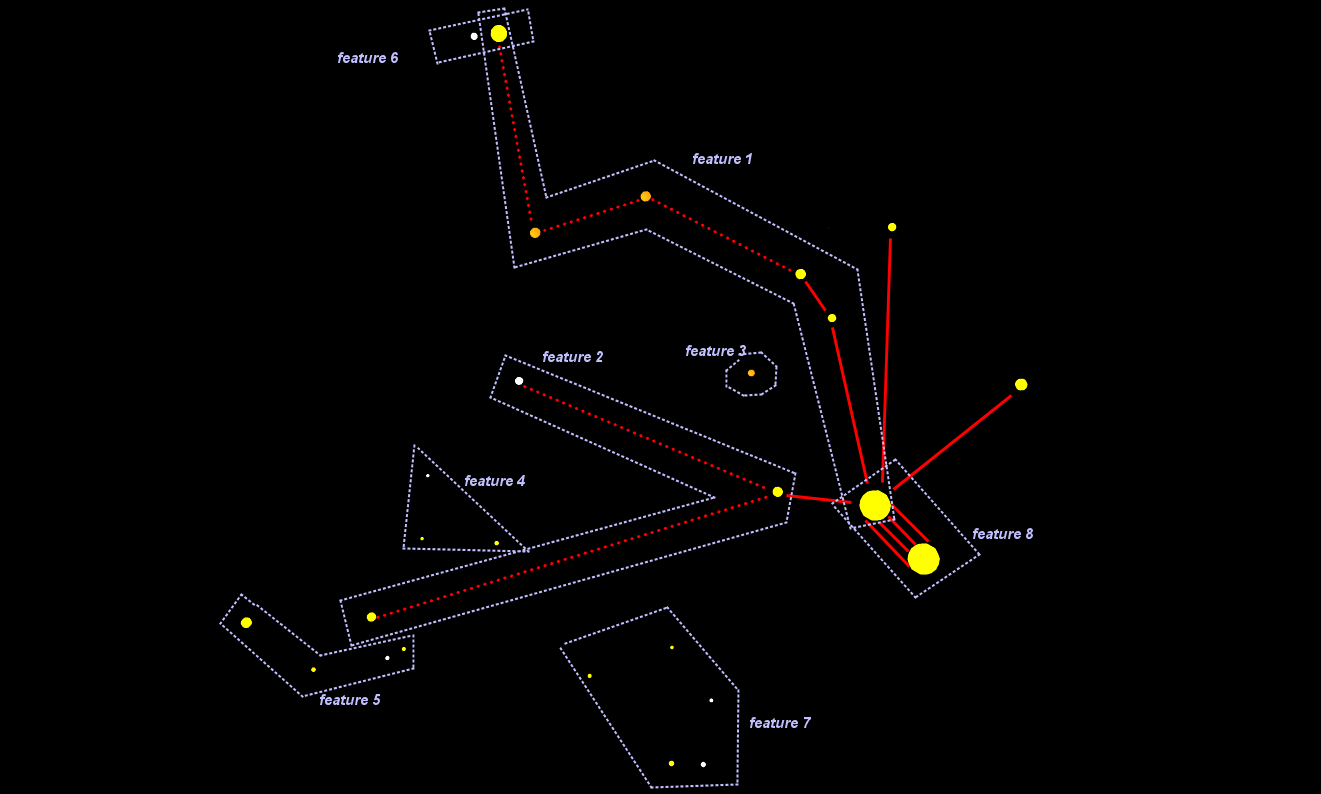
4 Zeta Reticuli stars as viewed from HIP 26737, RA: 85.21, DE: -31.35, Dist: 37.53Pc, 122.4ly
Blob analytics
We were very lucky, in that the Fish interpretation is very close match. With this as a starting point I was able to identify each of the seven groups in my 3D models of the interest group and of the stars within 46 parsec (150 ly) from Earth.
Group I. This group is clearly present. The Square Root symbol; this unmistakably shaped group stands out in a way that few others could hope to approximate. 100%
Group 2. Again; clearly present. Our greater than symbol is also difficult to confuse. 100%
Group 3. As a single star this group only has meaning in context with other nearby stars. In this case the stars of Group 1 serve as this context, and, again, 100%.
Group 4. The triangle, also clearly present. 100%
Group 5. The boomerang. Ours has a fourth star added to the end. It sort of seemed natural, there was this line of “G” class stars, all about the same distance… 100%
Group 6. Atop the terminus of the square root symbol is a small collection of stars. The original template shows 3 stars, but in a somewhat different configuration. Even allowing for memory issues it is difficult to resolve. If we take only the two left most stars as the group then we can allow enough artistic license to construe that the left most star is Upsilon Andromeda, and the “connected” star is Gliese 67. This at least ‘begins” to work, and may be close enough for some. However, for the purpose of this analysis; not close enough, thus a confidence of 40% is assigned.
Group 7. The Pentagon. Ours is a bit misshapen, though there are plenty of apparently suitable stars close by. That however is problematic; as it increases the likelihood of finding a “match” for a star. This gets a score of 30%.
Group 8. Binary pair. Zeta Reticuli 1 & 2 do indeed form a binary star system. They are separated by enough distance that neither would interfere with the planetary development, or in the evolution of life in each other. They are two closely spaced, yet independent, solar systems. 90%. This group is different from the others in that it consists of a single expanded star system, drilled down to the first level; thus we see the two (2) Zetas Reticuli. This is the only star subjected to such an action, and is the first indication that Betty’s “map” is actually a “copy” of a Graphical User Interface.
Our manual template matching, while not as accurate as the computerized method, shows that all of the image elements are present, even if not as well formed as we might like.
Stars
Astrometrics for stars selected for the map.
hip name age dist spClass planets dist. from ZR
1 7981 107 Piscis HIP7981 15 7.53 K1V 0 14.7917
2 8102 Tau Ceti HIP8102 5.8 3.65 G8.5V 4 12.27753
3 7918 HIP7918 6.1 12.74 G1V 0 20.23804
4 3093 54 Piscis HIP3093 15.9 11.06 K0V 1 17.6412
5 15510 82 Eridani HIP15510 11.3 6.04 G8V 3 7.99734
6 10138 HIP10138 10 10.78 G9V 1 4.59407
7 12843 Tau(1) Eridani HIP12843 3 14.21 F7V 0 8.96263
8 15330 Zeta(1) Reticuli HIP15330 3 12.01 G4V 0 3.29E-02 (6786.11 AU)
9 15371 Zeta(2) Reticuli HIP15371 3 12.03 G0V 0 0
10 29271 Alpha Mensae HIP29271 5.8 10.2 G7V 0 3.95263
11 7235 HIP7235 6.9 19.05 G8.5V 0 12.78767
12 11072 Kappa Fornacis HIP11072 5.7 21.95 G1V 0 13.34955
13 111170 HIP111170 3.7 25.4 F8V 0 28.32395
14 115126 94 Aquarii HIP115126 0 21.05 G8.5IV 0 21.75237
15 113421 HIP113421 7.5 19.86 G8IV-V 2 23.37408
16 3909 Phi(2) Ceti HIP3909 1 15.75 F7V 0 15.01912
17 9007 Chi Eridani HIP9007 0 17.85 G8IV 0 6.95701
18 7978 HIP7978 1.9 17.43 F9V 1 6.81604
19 99572 Xi(2) Capricorni 2.5 27.7 F7V Fe-0.5 0 34.53836
20 101345 HIP101345 7.8 24.4 G2V 0 31.18256
21 102203 HIP102203 4.4 30.63 G5 V 0 37.08924
22* 7513 Upsilon Andromedae 3.1 13.49 F9V 4 20.705
23 114703 HIP114703 0 24.86 G0V 0 25.76732
24 26737 HIP26737 7.7 37.53 G2V 0 29.61516
25 101933 HIP101933 0 39.19 N/A 0 48.24221
26 22451 HIP22451 1.4 17.74 K2 V 0 7.81401
(sorry about the table...apparently the current editor may not allow for even manual formatting)
Manual Template Matching
13 identified Stars
Marjorie Fish identified 13 primary stars that conformed to the template provided by Betty Hill.
1. Zeta (1) Reticuli
2. Zeta (2) Reticuli
3. Alpha Mensae
4. 82 Eridani
5. Tau Ceti
6. Sol
7. 107 Piscis
8. 54 Piscis
9. Gliese 67 Hip 7918
10. Gliese 86 Hip 10138
11. Tau (1) Eridani
12. Gliese 59A Hip 7235
13. Kappa Fornascis
The remainder of the stars are identified here:
14. HIP 22451
15. Upsilon Andromeda
16. Phi (2) Ceti
17. HIP 113421*
18. HIP 101933*
19. HIP 114703*
20. HIP 111170
21. HIP 102203*
22. HIP 101345
23. Xi(2) Capricorni
24. HIP 7978
25. Chi Eridani
26. HIP 26737 (the POV, not drawn on map, and outside search area)
(* unknown prior to 1992)
7 groups (blobs)
The original template seemed to lend itself rather well to the definition of seven (7) distinct groups or blobs.
i. The Square Root symbol. This group of stars resembles the mathematical Square Root symbol. I have included the single star of Group 3 in this because they do make for a “whole idea”
ii. The Greater than Sign. This structure resembles the mathematical “Greater Than” sign.
Note: blob 1 and 2 are the most significant aspects of the “blob” analytics. When taken with blob 3 it begins to form a sort of mathematical expression (“Triangle” > SQRT(“lonestar”) ). This “formation” affords us a valuable tool in evaluating possible matches.
iii. Our only single star group. It serves as a method to identify the specific “square root” symbol. When viewed in conjunction with blobs 1 and 2, this feature helps to form an unexpected feature to assist in the identifying process.
iv. The Triangle. A group of three stars forming a sort of triangle within the “Greater Than” sign.
v. The boomerang, this grouping of stars serves to further identify the “Grater Than” sign.
vi. This group of 3 stars that form a union with group 1 seems rather cramped, perhaps by the size of the page at original drawing time. In any case they help to identify the terminus of the Square Root symbol.
vii. The pentagon. This collection of 5 stars form a rough pentagram and help to identify the whole.
viii. The binary pair. While not shown in the “graphic” the host star is depicted as two “joined” stars; logic strongly suggests a binary star.

3 Break down of Template Objects

4 Zeta Reticuli stars as viewed from HIP 26737, RA: 85.21, DE: -31.35, Dist: 37.53Pc, 122.4ly
Blob analytics
We were very lucky, in that the Fish interpretation is very close match. With this as a starting point I was able to identify each of the seven groups in my 3D models of the interest group and of the stars within 46 parsec (150 ly) from Earth.
Group I. This group is clearly present. The Square Root symbol; this unmistakably shaped group stands out in a way that few others could hope to approximate. 100%
Group 2. Again; clearly present. Our greater than symbol is also difficult to confuse. 100%
Group 3. As a single star this group only has meaning in context with other nearby stars. In this case the stars of Group 1 serve as this context, and, again, 100%.
Group 4. The triangle, also clearly present. 100%
Group 5. The boomerang. Ours has a fourth star added to the end. It sort of seemed natural, there was this line of “G” class stars, all about the same distance… 100%
Group 6. Atop the terminus of the square root symbol is a small collection of stars. The original template shows 3 stars, but in a somewhat different configuration. Even allowing for memory issues it is difficult to resolve. If we take only the two left most stars as the group then we can allow enough artistic license to construe that the left most star is Upsilon Andromeda, and the “connected” star is Gliese 67. This at least ‘begins” to work, and may be close enough for some. However, for the purpose of this analysis; not close enough, thus a confidence of 40% is assigned.
Group 7. The Pentagon. Ours is a bit misshapen, though there are plenty of apparently suitable stars close by. That however is problematic; as it increases the likelihood of finding a “match” for a star. This gets a score of 30%.
Group 8. Binary pair. Zeta Reticuli 1 & 2 do indeed form a binary star system. They are separated by enough distance that neither would interfere with the planetary development, or in the evolution of life in each other. They are two closely spaced, yet independent, solar systems. 90%. This group is different from the others in that it consists of a single expanded star system, drilled down to the first level; thus we see the two (2) Zetas Reticuli. This is the only star subjected to such an action, and is the first indication that Betty’s “map” is actually a “copy” of a Graphical User Interface.
Our manual template matching, while not as accurate as the computerized method, shows that all of the image elements are present, even if not as well formed as we might like.
Stars
Astrometrics for stars selected for the map.
hip name age dist spClass planets dist. from ZR
1 7981 107 Piscis HIP7981 15 7.53 K1V 0 14.7917
2 8102 Tau Ceti HIP8102 5.8 3.65 G8.5V 4 12.27753
3 7918 HIP7918 6.1 12.74 G1V 0 20.23804
4 3093 54 Piscis HIP3093 15.9 11.06 K0V 1 17.6412
5 15510 82 Eridani HIP15510 11.3 6.04 G8V 3 7.99734
6 10138 HIP10138 10 10.78 G9V 1 4.59407
7 12843 Tau(1) Eridani HIP12843 3 14.21 F7V 0 8.96263
8 15330 Zeta(1) Reticuli HIP15330 3 12.01 G4V 0 3.29E-02 (6786.11 AU)
9 15371 Zeta(2) Reticuli HIP15371 3 12.03 G0V 0 0
10 29271 Alpha Mensae HIP29271 5.8 10.2 G7V 0 3.95263
11 7235 HIP7235 6.9 19.05 G8.5V 0 12.78767
12 11072 Kappa Fornacis HIP11072 5.7 21.95 G1V 0 13.34955
13 111170 HIP111170 3.7 25.4 F8V 0 28.32395
14 115126 94 Aquarii HIP115126 0 21.05 G8.5IV 0 21.75237
15 113421 HIP113421 7.5 19.86 G8IV-V 2 23.37408
16 3909 Phi(2) Ceti HIP3909 1 15.75 F7V 0 15.01912
17 9007 Chi Eridani HIP9007 0 17.85 G8IV 0 6.95701
18 7978 HIP7978 1.9 17.43 F9V 1 6.81604
19 99572 Xi(2) Capricorni 2.5 27.7 F7V Fe-0.5 0 34.53836
20 101345 HIP101345 7.8 24.4 G2V 0 31.18256
21 102203 HIP102203 4.4 30.63 G5 V 0 37.08924
22* 7513 Upsilon Andromedae 3.1 13.49 F9V 4 20.705
23 114703 HIP114703 0 24.86 G0V 0 25.76732
24 26737 HIP26737 7.7 37.53 G2V 0 29.61516
25 101933 HIP101933 0 39.19 N/A 0 48.24221
26 22451 HIP22451 1.4 17.74 K2 V 0 7.81401
(sorry about the table...apparently the current editor may not allow for even manual formatting)
edit on 8-3-2019 by james1947 because: (no reason given)
Here is the end of that portion of the analysis...
Star selection criteria
In lieu of additional data, it is probably safe to presume that life, at virtually all levels, and manifestations, exhibits a “Normal Distribution” across stellar class. Taking Sol/Earth as the only reference extant and applying the standard distribution we should find that stellar class “G5” is the center of our curve, and “M” class and “A” class as our extremes.
As stars become smaller and colder (progression of “M” class), the planets become tidally locked. While this doesn’t eliminate the probability of life, it will certainly affect the rate at which that life evolves. Thus even after 10’s of billions of years the life may not become advanced.
Conversely, as a star progresses toward class “A”, its life span shortens and any life developing will experience a shortened “evolution time”.
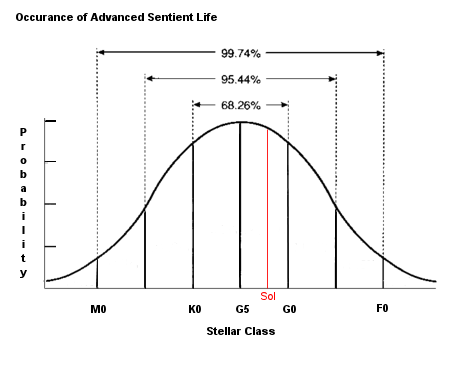
The advanced, nearly space faring species found on Earth took 4.6 billion years to evolve. A similar “track” should be presumed for all other planets until better information is available.
It is said that the source of the Hill Template was visitors from Zeta Reticuli; Zeta(s) Reticuli are estimated at 3 billion years (7.1 max) which may help to establish a lower limit for evolution time.
Thus the fundamental criteria for star selection is; be of stellar classification “F”, “G”, or “K”, and 3 billion or more years old.
Many of the thousands of available stars are “disqualified” early due to their “type” (as differentiated from “class”). For the most part only type “V” (main sequence) stars are suitable, other types indicate a dying star; for instance, a type IV star is called a “Sub giant”. In a type IV star; its internal structures have collapsed, and the star actually shrinks a little. Over a short time the star enlarges and engulfs its inner planets. We don’t seem to have much data on the dying process…yet. For instance; how long does a star remain in the different states of “dying”? Could a star remain in the “Giant” state long enough for life to evolve to an advanced level?
Math
So now, the big question; “What is this template Betty Hill gave us almost 60 years ago?”
We have seen than if applied to the local stars (within 33 parsec) that there is what appears to be a very close match, but, what of the chances of this being a random event?
We have a collection of 25 identified stars that conform well to the Hill template; applying probability…
We want the first 25 terms of 2826 factorial (2826 is the number of stars returned for our search): result = 1.7102778772488529E+86. So there are 1.71e+86 combinations of 25 stars, there are also 46,656,000 possible angles to view from. The probability of the match is: 1 chance in 7.978176e+93 or 1.25e-94.
The other factors, our groups, blobs, features, can be applied to a confidence value for this probability. There are 8 groups, of these groups 6 and 7 exhibit some issues, adjusting their effect on the whole alters the contribution of the groups and reduces it to 82.5%. (1.03125e-94)
Computer Template Matching software (AI) put the actual quality of a match at 99.1%
Thus the overall probability of the template being random is: 1.024e-94.
Vanishingly small.
Star selection criteria
In lieu of additional data, it is probably safe to presume that life, at virtually all levels, and manifestations, exhibits a “Normal Distribution” across stellar class. Taking Sol/Earth as the only reference extant and applying the standard distribution we should find that stellar class “G5” is the center of our curve, and “M” class and “A” class as our extremes.
As stars become smaller and colder (progression of “M” class), the planets become tidally locked. While this doesn’t eliminate the probability of life, it will certainly affect the rate at which that life evolves. Thus even after 10’s of billions of years the life may not become advanced.
Conversely, as a star progresses toward class “A”, its life span shortens and any life developing will experience a shortened “evolution time”.

The advanced, nearly space faring species found on Earth took 4.6 billion years to evolve. A similar “track” should be presumed for all other planets until better information is available.
It is said that the source of the Hill Template was visitors from Zeta Reticuli; Zeta(s) Reticuli are estimated at 3 billion years (7.1 max) which may help to establish a lower limit for evolution time.
Thus the fundamental criteria for star selection is; be of stellar classification “F”, “G”, or “K”, and 3 billion or more years old.
Many of the thousands of available stars are “disqualified” early due to their “type” (as differentiated from “class”). For the most part only type “V” (main sequence) stars are suitable, other types indicate a dying star; for instance, a type IV star is called a “Sub giant”. In a type IV star; its internal structures have collapsed, and the star actually shrinks a little. Over a short time the star enlarges and engulfs its inner planets. We don’t seem to have much data on the dying process…yet. For instance; how long does a star remain in the different states of “dying”? Could a star remain in the “Giant” state long enough for life to evolve to an advanced level?
Math
So now, the big question; “What is this template Betty Hill gave us almost 60 years ago?”
We have seen than if applied to the local stars (within 33 parsec) that there is what appears to be a very close match, but, what of the chances of this being a random event?
We have a collection of 25 identified stars that conform well to the Hill template; applying probability…
We want the first 25 terms of 2826 factorial (2826 is the number of stars returned for our search): result = 1.7102778772488529E+86. So there are 1.71e+86 combinations of 25 stars, there are also 46,656,000 possible angles to view from. The probability of the match is: 1 chance in 7.978176e+93 or 1.25e-94.
The other factors, our groups, blobs, features, can be applied to a confidence value for this probability. There are 8 groups, of these groups 6 and 7 exhibit some issues, adjusting their effect on the whole alters the contribution of the groups and reduces it to 82.5%. (1.03125e-94)
Computer Template Matching software (AI) put the actual quality of a match at 99.1%
Thus the overall probability of the template being random is: 1.024e-94.
Vanishingly small.
edit on 8-3-2019 by james1947 because: (no reason given)
Stars and Planets
1. HIP 26737. This is the star from which the whole of the map is being viewed. HIP 26737 is a Class G2V, 7.7 billion year old star 37.63 Parsec (121.9212ly) from Earth. Little is currently known about this star.
2. SOL. Earth’s own star, a Class G2V, 4.6 billion year old star some 93,000,000 miles from Earth. Sol has 8 planets, 4 inner rocky planets, at least one of which supports a virtual space faring civilization, and 4 outer gas giants, which have moons that may support life as well.
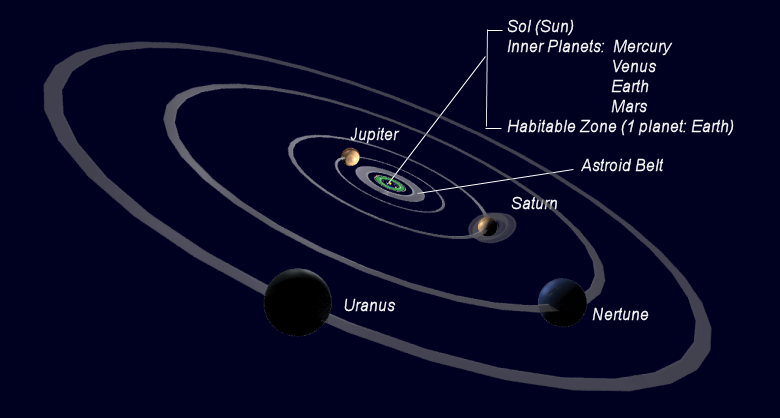
Planets:
Mercury:
Distance: 0.4 AU
Orbital Period: 87.97 Days
Size: 0.055 Earth Masses
Venus:
Distance: 0.7 AU
Orbital Period: 224.7 Days
Size: 0.815 Earth Masses
Earth:
Distance: 1 AU
Orbital Period: 365.256 Days
Size: 1 Earth Masses
Mars:
Distance: 1.5 AU
Orbital Period: 686.97 Days
Size: 0.107 Earth Masses
Jupiter:
Distance: 5.3 AU
Orbital Period: 11.862 Years
Size: 318 Earth Masses
Saturn:
Distance: 9.5 AU
Orbital Period: 29.457 Years
Size: 95 Earth Masses
Uranus:
Distance: 19.2 AU
Orbital Period: 84.02 Years
Size: 14 Earth Masses
Neptune:
Distance: 30.1 AU
Orbital Period: 164.8 Years
Size: 17 Earth Masses
3. Zeta (1) Reticuli One of our two “Origin” stars. Zeta(s) Reticuli are a binary pair of stars. Zeta (1) is a class G3 – 5V 31.6ly from Earth, there are no known planets. (GJ 136)
4. Zeta (2) Reticuli Our other Zeta. Zeta (2) is a class G2V star 39.24ly from Earth. There are no known planets, however, Zeta (2) does have a debris disk. (GJ 138)
5. Gliese 86 (primary) A binary system consisting of a class K1V (primary star) and a white dwarf class D?. The star system has one known planet orbiting at 0.11AU in an almost circular orbit of some 15.76 days. (GJ 86)
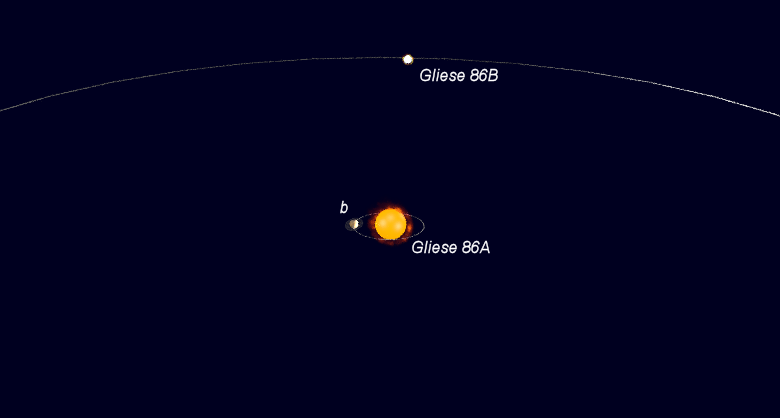
Planets:
GJ86b:
Distance: 0.1130 ± 0.0065 AU
Orbital Period: 15.76 Days
Size: >3.91 ± 0.32 MJ
6. Tau (1) Eridani (primary) a class F7V, 46ly from Earth. This a spectroscopic binary with an orbital period of 958 days. There doesn’t seem to be much on Tau (1)’s companion other than its long orbital period, however with the length of orbit, it must be located a respectable distance from the primary star, and thus have little effect on any inner planets, should they exist. (GJ 111)
7. Gliese 59A (primary) Also HIP 7235, a class K0V (according to simbad) star located 19ly from Earth. There are no known planets. (GJ 59)
8. Alpha Mensae (primary) a class G7V star located some 10.2ly from Earth. There are no known planets. (GJ 231)
9. 82 Eridani (primary) a class G8V located some 19.7ly from Earth. 82 Eridani is host to 3 confirmed planets, and 3 unconfirmed. A potentially Neptune sized candidate planet, 82 Eridani f, is orbiting within the habitable zone of the star. (GJ 139)
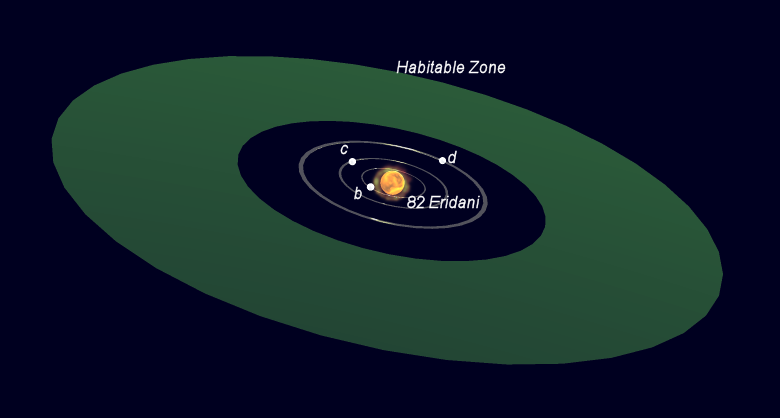
Planets
82 Eri g: unconfirmed
Distance: 0.095 AU
Period: 11.86 Days
Size: 1.03 Me
82 Eri b:
Distance: 0.1127 AU
Period: 18.33 Days
Size: 2.83 Me
82 Eri c: unconfirmed
Distance: 0.225 AU
Period: 43.17 Days
Size: 2.52 Me
82 Eri d:
Distance: 0.364 AU
Period: 88.49 Days
Size: 3.52 Me
82 Eri e:
Distance: 0.509 AU
Size: 4.77 Me
Period: 147.02 Days
82 Eri f: unconfirmed
Distance: 0.875 AU
Period: 341.41 Days
Size: 10.26 Me
10. Tau Ceti (primary) Class G8V about 11.9ly from Earth. Tau Ceti hosts 4 confirmed planets, 2 of which are within its Habitable Zone. (GJ 71)

Planets
Tau Ceti g:
Distance: 0.133 AU
Period: 20 Days
Size: 1.75 Me
Tau Ceti h:
Distance: 0.243 AU
Period: 49.41 Days
Size: 1.83 Me
Tau Ceti e:
Distance: 0.538 AU
Period: 162.87 Days
Size: 3.93 Me
Tau Ceti f:
Distance: 1.334 AU
Period: 636.13 Days
Size: 3.93 Me
11. 107 Piscis (primary) a class K1V star about 24.4ly from Earth. It has no confirmed planets. (GJ 68)
12. 54 Piscis (primary) Class K0V and T7.5 this binary system is located at 36.1ly has a single confirmed planet. It appears that the binary nature of this star wasn’t known until after 2002. (GJ 27)
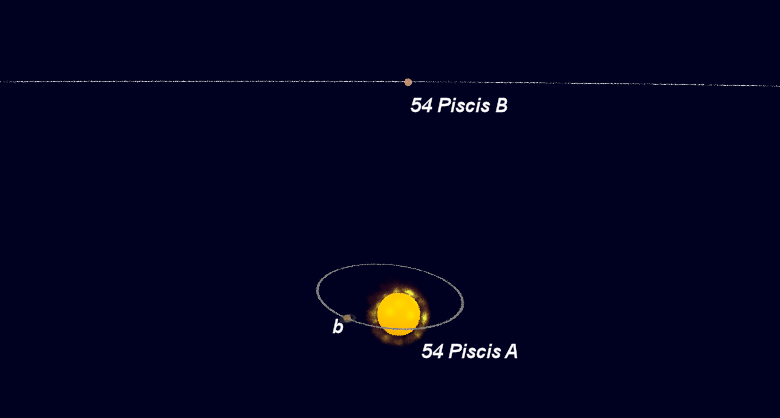
Planets
54 Piscis b:
Distance: 0.296 AU
Period: 62.206 Days
Size: 0.227 Mj
13. Gliese 67 a binary located 41.2 ly away, in Andromeda. The two stars orbit one another elliptically, approaching as close as 4.2 AU and receding to 10.5 AU, with a period of just under twenty years. There are no confirmed planets. (GJ 67)
(continued)
1. HIP 26737. This is the star from which the whole of the map is being viewed. HIP 26737 is a Class G2V, 7.7 billion year old star 37.63 Parsec (121.9212ly) from Earth. Little is currently known about this star.
2. SOL. Earth’s own star, a Class G2V, 4.6 billion year old star some 93,000,000 miles from Earth. Sol has 8 planets, 4 inner rocky planets, at least one of which supports a virtual space faring civilization, and 4 outer gas giants, which have moons that may support life as well.

Planets:
Mercury:
Distance: 0.4 AU
Orbital Period: 87.97 Days
Size: 0.055 Earth Masses
Venus:
Distance: 0.7 AU
Orbital Period: 224.7 Days
Size: 0.815 Earth Masses
Earth:
Distance: 1 AU
Orbital Period: 365.256 Days
Size: 1 Earth Masses
Mars:
Distance: 1.5 AU
Orbital Period: 686.97 Days
Size: 0.107 Earth Masses
Jupiter:
Distance: 5.3 AU
Orbital Period: 11.862 Years
Size: 318 Earth Masses
Saturn:
Distance: 9.5 AU
Orbital Period: 29.457 Years
Size: 95 Earth Masses
Uranus:
Distance: 19.2 AU
Orbital Period: 84.02 Years
Size: 14 Earth Masses
Neptune:
Distance: 30.1 AU
Orbital Period: 164.8 Years
Size: 17 Earth Masses
3. Zeta (1) Reticuli One of our two “Origin” stars. Zeta(s) Reticuli are a binary pair of stars. Zeta (1) is a class G3 – 5V 31.6ly from Earth, there are no known planets. (GJ 136)
4. Zeta (2) Reticuli Our other Zeta. Zeta (2) is a class G2V star 39.24ly from Earth. There are no known planets, however, Zeta (2) does have a debris disk. (GJ 138)
5. Gliese 86 (primary) A binary system consisting of a class K1V (primary star) and a white dwarf class D?. The star system has one known planet orbiting at 0.11AU in an almost circular orbit of some 15.76 days. (GJ 86)

Planets:
GJ86b:
Distance: 0.1130 ± 0.0065 AU
Orbital Period: 15.76 Days
Size: >3.91 ± 0.32 MJ
6. Tau (1) Eridani (primary) a class F7V, 46ly from Earth. This a spectroscopic binary with an orbital period of 958 days. There doesn’t seem to be much on Tau (1)’s companion other than its long orbital period, however with the length of orbit, it must be located a respectable distance from the primary star, and thus have little effect on any inner planets, should they exist. (GJ 111)
7. Gliese 59A (primary) Also HIP 7235, a class K0V (according to simbad) star located 19ly from Earth. There are no known planets. (GJ 59)
8. Alpha Mensae (primary) a class G7V star located some 10.2ly from Earth. There are no known planets. (GJ 231)
9. 82 Eridani (primary) a class G8V located some 19.7ly from Earth. 82 Eridani is host to 3 confirmed planets, and 3 unconfirmed. A potentially Neptune sized candidate planet, 82 Eridani f, is orbiting within the habitable zone of the star. (GJ 139)

Planets
82 Eri g: unconfirmed
Distance: 0.095 AU
Period: 11.86 Days
Size: 1.03 Me
82 Eri b:
Distance: 0.1127 AU
Period: 18.33 Days
Size: 2.83 Me
82 Eri c: unconfirmed
Distance: 0.225 AU
Period: 43.17 Days
Size: 2.52 Me
82 Eri d:
Distance: 0.364 AU
Period: 88.49 Days
Size: 3.52 Me
82 Eri e:
Distance: 0.509 AU
Size: 4.77 Me
Period: 147.02 Days
82 Eri f: unconfirmed
Distance: 0.875 AU
Period: 341.41 Days
Size: 10.26 Me
10. Tau Ceti (primary) Class G8V about 11.9ly from Earth. Tau Ceti hosts 4 confirmed planets, 2 of which are within its Habitable Zone. (GJ 71)

Planets
Tau Ceti g:
Distance: 0.133 AU
Period: 20 Days
Size: 1.75 Me
Tau Ceti h:
Distance: 0.243 AU
Period: 49.41 Days
Size: 1.83 Me
Tau Ceti e:
Distance: 0.538 AU
Period: 162.87 Days
Size: 3.93 Me
Tau Ceti f:
Distance: 1.334 AU
Period: 636.13 Days
Size: 3.93 Me
11. 107 Piscis (primary) a class K1V star about 24.4ly from Earth. It has no confirmed planets. (GJ 68)
12. 54 Piscis (primary) Class K0V and T7.5 this binary system is located at 36.1ly has a single confirmed planet. It appears that the binary nature of this star wasn’t known until after 2002. (GJ 27)

Planets
54 Piscis b:
Distance: 0.296 AU
Period: 62.206 Days
Size: 0.227 Mj
13. Gliese 67 a binary located 41.2 ly away, in Andromeda. The two stars orbit one another elliptically, approaching as close as 4.2 AU and receding to 10.5 AU, with a period of just under twenty years. There are no confirmed planets. (GJ 67)
(continued)
cont.
14. Upsilon Andromeda a binary star system located about 44ly from Earth. Its class is F8V and M4.5V the separation of these stars is estimated to be around 750AU, which means the Red Dwarf companion would have no effect on any planets of the primary star. There are 4 confirmed planets. (GJ 61)
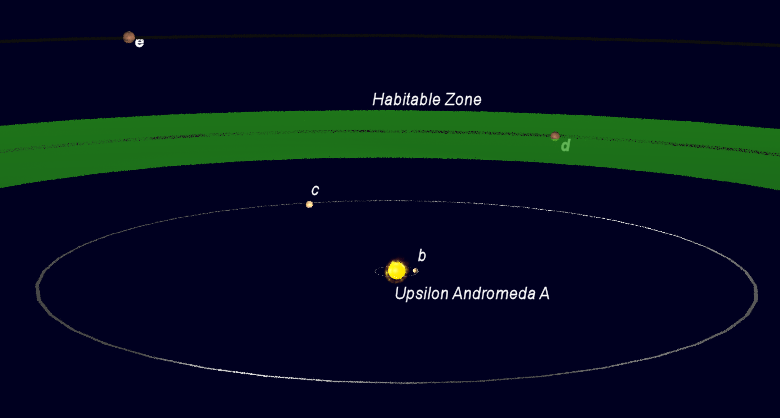
Planets
Ups And b
Distance: 0.059 AU
Period: 4.671 Days
Size: 0.62 Mj
Ups And c
Distance: 0.861 AU
Period: 240.937 Days
Size: 9.1 Mj
Ups And d
Distance: 2.55 AU
Period: 1281.439 Days
Size: 23.53 Mj
Ups And e
Distance: 5.2456 AU
Period: 3848.86 Days
Size: 1.059 Mj
15. HIP 22451 A class K2V located 17.7ly from Earth. There are no known planets. (GJ 3317)
16. Phi (2) Ceti (triangle) this class F7V star was misidentified by Ms. Fish in her late 60’s analysis of Betty Hill’s map. Ms. Fish thought it to be Kappa Fornacis, which while still belonging to this map, is not located here.
At 51.4ly this star is the correct designation for the “top” of the “triangle” object on Betty’s map. There are no confirmed planets. (GJ 37)
17. HIP 113421 (triangle) a class G8IV - V star 19.86ly from Earth. There are 2 confirmed planets. (---)
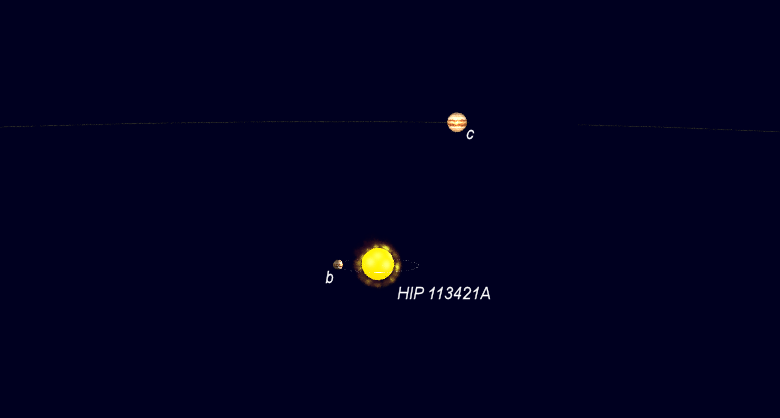
Planets
HIP 113421 b:
Distance: 0.073 AU
Period: 7.12689 Days
Size: 1.33 Mj
HIP 113421 c:
Distance: 5.27 AU
Period: 4210 Days
Size: 2.49 Mj
18. HIP 101933 (triangle) a mystery star located some 39.19ly from Earth. This star is a mystery because there is very little data available on it. (---)
19. Kappa Fornacis (boomerang) has moved and become the lead star of out “boomerang” group. Kappa Fornacis is a multiple star system. The major star is a class G1V – IV star, it has two class M0V stars as companions. There are no confirmed planets. (GJ 97)
20. HIP 114703 (boomerang) is a G0V, 24.86ly away. It has no confirmed planets. (---)
21. HIP 111170 (boomerang) a class F8V star 25.4ly from Earth. It has no confirmed planets. (GJ 862.1)
22. HIP 115126 (boomerang) (GJ 894.2 A) is a triple star system. The inner pair of this triple star system form a spectroscopic binary. The primary component of this pair has a stellar classification of G8.5IV, a subgiant star. The other component of this pair is a class K2V. No data on the third star found. Located 21.05ly from Earth, there are no known planets.
23. HIP 102203 (pentagram) (---) Class G5V located some 30.6ly from Earth. There are no known planets.
24. HIP 101345 (pentagram) (---) a class G2V star located 24.4ly from Earth. (GJ 792.1 A)
25. XI (2) Capricorni (pentagram) (GI 4139) is a class F7V star located 27.7ly from Earth. There are no known planets.
26. HIP 7978 (pentagram) (GJ 3109) Class F9V star located 17.43ly from Earth. There is 1 confirmed planet.
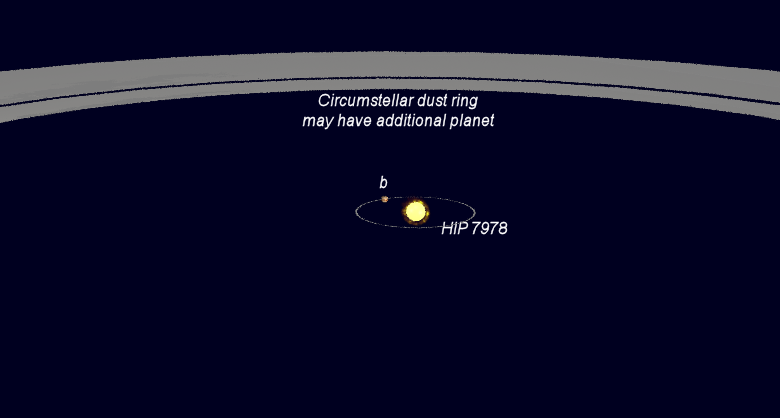
Planets
HIP 7978 b:
Distance: 2.03 AU
Period: 1003 Days
Size: 0.93 Mj
27. Chi Eridani (pentagram) (GJ 81) A class G8IV sub-giant star located 17.85ly from Earth. There are no known planets.
(cont)
14. Upsilon Andromeda a binary star system located about 44ly from Earth. Its class is F8V and M4.5V the separation of these stars is estimated to be around 750AU, which means the Red Dwarf companion would have no effect on any planets of the primary star. There are 4 confirmed planets. (GJ 61)

Planets
Ups And b
Distance: 0.059 AU
Period: 4.671 Days
Size: 0.62 Mj
Ups And c
Distance: 0.861 AU
Period: 240.937 Days
Size: 9.1 Mj
Ups And d
Distance: 2.55 AU
Period: 1281.439 Days
Size: 23.53 Mj
Ups And e
Distance: 5.2456 AU
Period: 3848.86 Days
Size: 1.059 Mj
15. HIP 22451 A class K2V located 17.7ly from Earth. There are no known planets. (GJ 3317)
16. Phi (2) Ceti (triangle) this class F7V star was misidentified by Ms. Fish in her late 60’s analysis of Betty Hill’s map. Ms. Fish thought it to be Kappa Fornacis, which while still belonging to this map, is not located here.
At 51.4ly this star is the correct designation for the “top” of the “triangle” object on Betty’s map. There are no confirmed planets. (GJ 37)
17. HIP 113421 (triangle) a class G8IV - V star 19.86ly from Earth. There are 2 confirmed planets. (---)

Planets
HIP 113421 b:
Distance: 0.073 AU
Period: 7.12689 Days
Size: 1.33 Mj
HIP 113421 c:
Distance: 5.27 AU
Period: 4210 Days
Size: 2.49 Mj
18. HIP 101933 (triangle) a mystery star located some 39.19ly from Earth. This star is a mystery because there is very little data available on it. (---)
19. Kappa Fornacis (boomerang) has moved and become the lead star of out “boomerang” group. Kappa Fornacis is a multiple star system. The major star is a class G1V – IV star, it has two class M0V stars as companions. There are no confirmed planets. (GJ 97)
20. HIP 114703 (boomerang) is a G0V, 24.86ly away. It has no confirmed planets. (---)
21. HIP 111170 (boomerang) a class F8V star 25.4ly from Earth. It has no confirmed planets. (GJ 862.1)
22. HIP 115126 (boomerang) (GJ 894.2 A) is a triple star system. The inner pair of this triple star system form a spectroscopic binary. The primary component of this pair has a stellar classification of G8.5IV, a subgiant star. The other component of this pair is a class K2V. No data on the third star found. Located 21.05ly from Earth, there are no known planets.
23. HIP 102203 (pentagram) (---) Class G5V located some 30.6ly from Earth. There are no known planets.
24. HIP 101345 (pentagram) (---) a class G2V star located 24.4ly from Earth. (GJ 792.1 A)
25. XI (2) Capricorni (pentagram) (GI 4139) is a class F7V star located 27.7ly from Earth. There are no known planets.
26. HIP 7978 (pentagram) (GJ 3109) Class F9V star located 17.43ly from Earth. There is 1 confirmed planet.

Planets
HIP 7978 b:
Distance: 2.03 AU
Period: 1003 Days
Size: 0.93 Mj
27. Chi Eridani (pentagram) (GJ 81) A class G8IV sub-giant star located 17.85ly from Earth. There are no known planets.
(cont)
(cont)
Pathways
Betty Hill described the map as “Trade and Exploration routes”. This would seem logical, though what Betty saw may not have been a navigational aid.
Beginning the two (2) pathways are two (2) of four (4) “trade” routes. Of these 4 routes 3 have known planets, and only one of those is known to have life, and, that is the limit of our knowledge.
Falling back to our groups, two are of particular interest.
Route 1: Group 1, the “square root symbol” consists of 5 stars:
1. 82 Eridani: Class G8V, 11 billion years, 6 planets (3 unconfirmed), 26.05ly (from Zeta(2) Reticuli)
2. Tau Ceti: Class G8.5V, 5.8 billion years, 4 planets (2 in HZ), 40.019ly (from ZR)
3. 107 Piscium: Class K1V, 6.3 billion years, no known planets, 48.238ly(from ZR)
4. 54 Piscium: Class K0V/T7.5V (binary), 6.4 billion years, 1 known planet, 57.53ly
5. Gliese 67: Class G1V, 6.1 billion, no known planets, 65.98ly
Route 2: Group 2, our “greater than” symbol consists of three stars:
1. Gliese 86: Class K1V/D? (binary), 10 billion years, 1 known planet, 14.97ly
2. Tau(1) Eridani: Class F7V, 3 billion years, no known planets, 29.22ly
3. Gliese 59A: Class K0V, age unknown, no known planets, 41.68ly
Route 3: The Sun. Class G2V, 4.6 Billion years old, 8 planets, 1 advanced civilization.
Route 4: Alpha Mensae. Class G7V, 5.8 Billion years old, no known planets, 10.2ly
Predictions
It has been said that one of the things that can go a very long way to “proving” Extraterrestrial involvement with Earth and the abduction of Humans; is for an abductee to return with knowledge gained from the Extraterrestrials that is later proven by science. Such is the case here, there are 4 stars in the original map that were unknown until the Hipparcos Mission of the early 1990’s.
1. HIP 113421*
2. HIP 101933*
3. HIP 114703*
4. HIP 102203*

Conclusions
Given the impossible nature of the task (probability = 1.024e-94) of creating a random grouping of points or “dots” that match actual stars within local space (33 parsec) without previous knowledge, and with features not yet known (binary nature of Zeta(s) Reticuli, four (4) undiscovered stars). It would appear that the template is a close approximation (99.1%) of something real and provided by extraterrestrial visitors; making the template an artifact of Extraterrestrial visitation.
Graphical User Interface
Betty claimed the map showed “stars and planets”; this isn’t logical. The two are different orders of magnitude when applied to distance, planets are millions of miles, and stars are light years. Showing both on the same display wouldn’t work well, and would be confusing.
However, IF the display were designed in a logical manner, it might be something quite like our modern Graphical User Interfaces (GUI). There is a que in Betty’s map that suggests that she actually drew a GUI. The two Zetas Reticuli are both shown on the map, and while they are both stars, the magnitude of the distance separating them is something between the planetary scales, and the stellar scale.
The two Zeta Reticuli stars are a wide binary, which means that the two stars orbit the same gravimetric center, but at a distance from each other that they will not interfere with planetary systems of each other.
So, we see two Zetas Reticuli and a collection of stars. Actually what we are seeing is a collection of stars with one expanded to the top level view of the solar system; in this case two stars. Drilling down further would result in the individual planetary systems…unfortunately for us, we don’t have the information on those exoplanets, yet.
Drilling down on any of the other stars will also result in the display of progressively deeper information about the star, to the limit of data.
In this way, Betty’s map contains both stars and planets.
While Betty’s psychology, and much of her imagery may be questionable; this map is something that can be removed from the foul effects of psychology, etc. The quality of the match to stars viewed from 122 light years from Earth, the logic of the map’s schema, and the four stellar predictions strongly indicate Extraterrestrial influence.
Pathways
Betty Hill described the map as “Trade and Exploration routes”. This would seem logical, though what Betty saw may not have been a navigational aid.
Beginning the two (2) pathways are two (2) of four (4) “trade” routes. Of these 4 routes 3 have known planets, and only one of those is known to have life, and, that is the limit of our knowledge.
Falling back to our groups, two are of particular interest.
Route 1: Group 1, the “square root symbol” consists of 5 stars:
1. 82 Eridani: Class G8V, 11 billion years, 6 planets (3 unconfirmed), 26.05ly (from Zeta(2) Reticuli)
2. Tau Ceti: Class G8.5V, 5.8 billion years, 4 planets (2 in HZ), 40.019ly (from ZR)
3. 107 Piscium: Class K1V, 6.3 billion years, no known planets, 48.238ly(from ZR)
4. 54 Piscium: Class K0V/T7.5V (binary), 6.4 billion years, 1 known planet, 57.53ly
5. Gliese 67: Class G1V, 6.1 billion, no known planets, 65.98ly
Route 2: Group 2, our “greater than” symbol consists of three stars:
1. Gliese 86: Class K1V/D? (binary), 10 billion years, 1 known planet, 14.97ly
2. Tau(1) Eridani: Class F7V, 3 billion years, no known planets, 29.22ly
3. Gliese 59A: Class K0V, age unknown, no known planets, 41.68ly
Route 3: The Sun. Class G2V, 4.6 Billion years old, 8 planets, 1 advanced civilization.
Route 4: Alpha Mensae. Class G7V, 5.8 Billion years old, no known planets, 10.2ly
Predictions
It has been said that one of the things that can go a very long way to “proving” Extraterrestrial involvement with Earth and the abduction of Humans; is for an abductee to return with knowledge gained from the Extraterrestrials that is later proven by science. Such is the case here, there are 4 stars in the original map that were unknown until the Hipparcos Mission of the early 1990’s.
1. HIP 113421*
2. HIP 101933*
3. HIP 114703*
4. HIP 102203*

Conclusions
Given the impossible nature of the task (probability = 1.024e-94) of creating a random grouping of points or “dots” that match actual stars within local space (33 parsec) without previous knowledge, and with features not yet known (binary nature of Zeta(s) Reticuli, four (4) undiscovered stars). It would appear that the template is a close approximation (99.1%) of something real and provided by extraterrestrial visitors; making the template an artifact of Extraterrestrial visitation.
Graphical User Interface
Betty claimed the map showed “stars and planets”; this isn’t logical. The two are different orders of magnitude when applied to distance, planets are millions of miles, and stars are light years. Showing both on the same display wouldn’t work well, and would be confusing.
However, IF the display were designed in a logical manner, it might be something quite like our modern Graphical User Interfaces (GUI). There is a que in Betty’s map that suggests that she actually drew a GUI. The two Zetas Reticuli are both shown on the map, and while they are both stars, the magnitude of the distance separating them is something between the planetary scales, and the stellar scale.
The two Zeta Reticuli stars are a wide binary, which means that the two stars orbit the same gravimetric center, but at a distance from each other that they will not interfere with planetary systems of each other.
So, we see two Zetas Reticuli and a collection of stars. Actually what we are seeing is a collection of stars with one expanded to the top level view of the solar system; in this case two stars. Drilling down further would result in the individual planetary systems…unfortunately for us, we don’t have the information on those exoplanets, yet.
Drilling down on any of the other stars will also result in the display of progressively deeper information about the star, to the limit of data.
In this way, Betty’s map contains both stars and planets.
While Betty’s psychology, and much of her imagery may be questionable; this map is something that can be removed from the foul effects of psychology, etc. The quality of the match to stars viewed from 122 light years from Earth, the logic of the map’s schema, and the four stellar predictions strongly indicate Extraterrestrial influence.
edit on 8-3-2019 by james1947 because: (no reason given)
So aliens came to Earth, abducted Betty Hill, and gave her a window seat, because the aliens were very nice to humans, and let Betty see all the stars
near their planet, which was millions of light years from Earth.
The aliens showed in-flight alien movies, along the way, too. She got alien peanuts, and alien whisky, with aged cheese.
But the aliens made her forget everything but the stars, which she could map from deep hypnosis. Astronomers have confirmed the star maps are accurate, but nobody else can see them, but those astronomers.
And of course, they're all honest folks, so why wouldn't we believe everything they say is the truth??
The aliens showed in-flight alien movies, along the way, too. She got alien peanuts, and alien whisky, with aged cheese.
But the aliens made her forget everything but the stars, which she could map from deep hypnosis. Astronomers have confirmed the star maps are accurate, but nobody else can see them, but those astronomers.
And of course, they're all honest folks, so why wouldn't we believe everything they say is the truth??
a reply to: james1947
Do you think it's possible that you've gone too far down the rabbit hole to come back.
Obviously you are correct and I'm not questioning any of your proofs, BUT...
If by some freak occurrence you were wrong, do you think it would be possible for you to recognise it?
I know with 9/11 I've convinced myself of too many facts to honestly question my beliefs.
Do you think it's possible that you've gone too far down the rabbit hole to come back.
Obviously you are correct and I'm not questioning any of your proofs, BUT...
If by some freak occurrence you were wrong, do you think it would be possible for you to recognise it?
I know with 9/11 I've convinced myself of too many facts to honestly question my beliefs.
originally posted by: turbonium1
So aliens came to Earth, abducted Betty Hill, and gave her a window seat, because the aliens were very nice to humans, and let Betty see all the stars near their planet, which was millions of light years from Earth.
The aliens showed in-flight alien movies, along the way, too. She got alien peanuts, and alien whisky, with aged cheese.
But the aliens made her forget everything but the stars, which she could map from deep hypnosis. Astronomers have confirmed the star maps are accurate, but nobody else can see them, but those astronomers.
And of course, they're all honest folks, so why wouldn't we believe everything they say is the truth??
You nailed it right there. The aspect of the stars would change in that voyage. Which aspect are we looking at? From Earth. (The name earth is always interesting. How do aliens know we call our planet Earth?). So Betty was shown a star map. Where can you match this map from. Earth? Mate, go interstellar and that map does not represent what astronomers perceive, from the surface of this planet, nor would it represent even what an orbital telescope records.
The tragedy here is Betty sees a map. Draws it later. A map looking from where? If it is an interstellar spec then bets are off that the star pattern is from this planet.
Now, for a spaceship to navigate from a 2D map would be another tragedy. If it was a 3D map and you could walk around it surely then the aspect would change considerable, side to side, top to bottom.
So how would this Betty mapping system be regulated and more importantly navigated upon.
Now questions remain, where was Betty in the really big area of space when she saw the map.
Why a 2D map projection?
How does this map represent anything we perceive from here when Betty was in space?
Why would Aliens proffer a trading/navigating map, as seen from Earth?
I could go on,
But
Kind regards,
Bally
originally posted by: turbonium1
But the aliens made her forget everything but the stars, which she could map from deep hypnosis. Astronomers have confirmed the star maps are accurate, but nobody else can see them, but those astronomers.
And of course, they're all honest folks, so why wouldn't we believe everything they say is the truth??
Ya know, the stars in the map, and even the ones that aren't shown, have their positions relative to Earth recorded in several datasets. So where these stars are is very well known, and, you, or indeed anyone can use those datasets to locate any known star and view it with your own eyes, and telescope. This allows YOU to actually verify what the Astronomers "see".
I used a dataset known as Hipparcos. It contains Astrometric data on over 118,000 near by stars. I used that data to build a 3D model of all Hipparcos stars within 33 parsec of Earth, that allowed me to view these stars from any where I wanted. So, my view wasn't limited to just "from Earth".
And, here's why scientists don't have to be quite so honest: All of the data used is public data, and can be verified by anyone who cares, and has the skills.
edit on 9-3-2019 by james1947 because: (no reason given)
originally posted by: Krahzeef_Ukhar
a reply to: james1947
Do you think it's possible that you've gone too far down the rabbit hole to come back.
Obviously you are correct and I'm not questioning any of your proofs, BUT...
If by some freak occurrence you were wrong, do you think it would be possible for you to recognise it?
I know with 9/11 I've convinced myself of too many facts to honestly question my beliefs.
Yes...I currently don't see this project any different than any other project I engaged in over the past 45 years or so. It seems to be a rather straightforward data analysis problem, with some additional software to augment the analysis.
Now, IF it turned out wrong, for what ever reason; I would probably go back into the analysis in an attempt to find out where my logic broke down and lead to a false positive. And, I suppose I wouldn't be very happy about it, but, being wrong is something we all have to learn to deal with, and I've had 72 years to learn.
originally posted by: ArMaP
a reply to: bally001
a reply to: turbonium1
I think the whole discussion comes from the fact(?) that the map did not represent a view from Earth but from an unknown point in space.
Yes that is correct! Betty's map is being viewed from somewhere near HIP-26737.
26737 is a class G2V star 122 light years from here, and is where ALL my work is viewed from.
originally posted by: bally001
Now, for a spaceship to navigate from a 2D map would be another tragedy. If it was a 3D map and you could walk around it surely then the aspect would change considerable, side to side, top to bottom.
So how would this Betty mapping system be regulated and more importantly navigated upon.
Now questions remain, where was Betty in the really big area of space when she saw the map.
Why a 2D map projection?
How does this map represent anything we perceive from here when Betty was in space?
2D?!? ALL of the "maps" I used were 3D! You can see some of the 3D images I used in my paper.
Oh...I'm sorry!!! I forgot, you can't see a 3D image on your monitor as it is only 2D!
Do you see where that isn't a valid argument? I pull up that map on my system and represent it as 3D, and it works just as you might want it to, but, when I show it to you , it becomes 2D simply because there is no way for you to see it in 3D, and that sir, is a technological limitation.
I'm reminded that somewhere in Betty's ramblings about her experience she mentioned that looking at this "map" (display) was like looking through a window.
Ya know, when I decide to take a break, and fire up World of Warcraft...that "view" I have of "Azeroth" is just like that!!! Like looking through a window into a 3D environment.
But, still, when displayed on a 2D monitor...the image becomes 2D.
Betty never went into space.
edit on 9-3-2019 by james1947 because: (no reason given)
a reply to: james1947
Interesting stuff mate. Can I ask if you've worked out what the difference is in distance from the viewing position to the Zeta Reticuli binary stars? Are we in close vicinity? I've always thought it'd be interesting if those two were somehow in perspective to the rest of the stars on display (at least in terms of their possible closeness relative to the other stars).
Interesting stuff mate. Can I ask if you've worked out what the difference is in distance from the viewing position to the Zeta Reticuli binary stars? Are we in close vicinity? I've always thought it'd be interesting if those two were somehow in perspective to the rest of the stars on display (at least in terms of their possible closeness relative to the other stars).
originally posted by: james1947
Are you aware that you have your colors reversed? Those "Red" dots are mine. lol
Watch: Change your dots to red and Betty's to white. Okay, now show me how that makes a bit of difference in showing how your map still doesn't match Betty's, which is my point.
originally posted by: james1947
However, IF the display were designed in a logical manner, it might be something quite like our modern Graphical User Interfaces (GUI). There is a que in Betty’s map that suggests that she actually drew a GUI.
He asked me where the earth is on this map
When the "leader alien", not Betty, mentions Earth specifically, that's the end of your GUI map star theory.
How about another logical angle? You're too caught up in the accuracy of Betty recalling 25 points on a map that was probably shown to her for 10 seconds. A map that she admitted meant nothing to her and would be meaningless to remember and yet you have all of the stars laid out as if this was accurate. If this story was true, the number of dots and arrangement would be the least likely part she would remember. After one of her hypnotic sessions, Betty was sent home by her psychiatrist and under post-hypnotic suggestion was asked to draw the map. She later sat at her kitchen table and drew it. Since studies have shown that hypnosis is no better than conscious recall when it comes to small details and false memories are likely, the chances that her map being an exact copy of an alien map are slim.
The supposed abduction happened on Sept 19/20 1961. Betty was asked to redraw the map 3 years later in 1964. She kept a dream journal where she would write down details of her abduction dreams. It wasn't important enough for her to draw the layout of stars/planets on the map in 1961 and only did so after being told to by her doctor in 1964. So even being shown a physical map while recognizing she needed and wanted physical evidence, she didn't feel it was important enough to remember the positions of everything? This would have been fresh in her memory in 1961. Not only with the story, but the map is filled with holes, inconsistencies, and defies logic.
Why not draw a map with 25 dots randomly placed on a sheet of paper with lines connecting a few of them. Show a family member the map for 10 seconds and put it away- The idea is to show someone without them knowing it has to be remembered. Nearly 3 years later ask them to draw that map you showed them. Do you honestly believe they will remember the number of dots drawn on that paper? Why not hypnotize them? Hypnosis doesn't create a snapshot in your mind giving you the ability to copy exactly what you saw. In fact, The American Medical Association and the American Psychological Association don't even support hypnotherapy as a method for recovered memories.
originally posted by: Defragmentor
a reply to: james1947
Interesting stuff mate. Can I ask if you've worked out what the difference is in distance from the viewing position to the Zeta Reticuli binary stars? Are we in close vicinity? I've always thought it'd be interesting if those two were somehow in perspective to the rest of the stars on display (at least in terms of their possible closeness relative to the other stars).
Zeta(s) Reticuli are just under 40 light years. The Point-of-view is another 80 light years
The two Zetas are 6786 AU apart (6786 times the distance from Earth to the Sun). This seems to be a rather wide separation for Binary Stars.
originally posted by: Ectoplasm8
Watch: Change your dots to red and Betty's to white. Okay, now show me how that makes a bit of difference in showing how your map still doesn't match Betty's, which is my point.
Here's my point; that kind of goes to your ability to visually perceive things accurately. Sorry man, but y'all didn't do very well with that.
He asked me where the earth is on this map
When the "leader alien", not Betty, mentions Earth specifically, that's the end of your GUI map star theory.
lol...I can show you on my rough GUI simulation exactly where Earth is. AND, if you look above you can see the image the GUI has for Earth...well the Solar System anyway. The point is a GUI contains all of that information, in a logical schema.
... the chances that her map being an exact copy of an alien map are slim.
You are reinforcing the very same points I have. Which is "why" Betty's map is only a template, a kind of "pattern" to look for in stars (we can presume that those "stars" have planets, even IF undiscovered).
Not only with the story, but the map is filled with holes, inconsistencies, and defies logic.
Actually, the map has no holes, no inconsistencies, and is quite logical. If you think you have found a hole, or inconsistency, you should point it out explicitly, instead of simply "claiming" you have found something.
Why not draw a map with 25 dots randomly placed on a sheet of paper with lines connecting a few of them. Show a family member the map for 10 seconds and put it away- The idea is to show someone without them knowing it has to be remembered. Nearly 3 years later ask them to draw that map you showed them. Do you honestly believe they will remember the number of dots drawn on that paper? Why not hypnotize them? Hypnosis doesn't create a snapshot in your mind giving you the ability to copy exactly what you saw. In fact, The American Medical Association and the American Psychological Association don't even support hypnotherapy as a method for recovered memories.
And this would prove what? That probability is alive and well? You have read the probability of Betty's map being random chance, right? Just in case: 1.024e-94 ... that value is so small that there is little justification in considering it.
Look; I've shown that the all the picture elements are present in both images, and with a reasonable "visual" resemblance to be able to identify the element. This is true for all elements. I've shown that when Template matching software is applied, there is an extremely close match (99.1%), further that is the closest match found so far, despite several others attempting to find better matches. I have further shown that the "paths" described by the original map are logical, progressive, and in spite of what you seem to insist isn't true, full of planets. In fact, there are 24 known planets contained within that map.
So, I guess, we kind of need to attribute yet another prediction to the map; the presence of Planets...so that's 16 planets and 4 stars that Betty predicted...with more planets coming. That is hard to beat...
edit on 9-3-2019 by james1947 because: (no reason given)
new topics
-
Former DOJ charged with defrauding Rep. Matt Gaetz’s family over sex-crimes investigation
Propaganda Mill: 1 hours ago
top topics
-
The mysterious death of Aileen Conway
General Chit Chat: 16 hours ago, 6 flags -
Swedish Minister for Gender Equality is Seeking Treatment for Phobia of Bananas
Other Current Events: 12 hours ago, 6 flags -
Former DOJ charged with defrauding Rep. Matt Gaetz’s family over sex-crimes investigation
Propaganda Mill: 1 hours ago, 5 flags -
USA-BIDEN and CHINA-Xi Agree Not To Let Artificial Intelligence Decide Nuclear Weapons Use.
World War Three: 13 hours ago, 3 flags -
Satanic ‘Little Season’ of Deception.. Awaken to the Handiwork of the Creator.
ATS Skunk Works: 13 hours ago, 3 flags
active topics
-
Former DOJ charged with defrauding Rep. Matt Gaetz’s family over sex-crimes investigation
Propaganda Mill • 4 • : fringeofthefringe -
I’m Looking for Information on the Light We See at Death.
The Gray Area • 65 • : whereislogic -
President-elect TRUMP Picks MATT GAETZ for his ATTORNEY GENERAL - High Level PANIC Ensues.
2024 Elections • 94 • : RickinVa -
The art of being offended
Social Issues and Civil Unrest • 53 • : andy06shake -
Swedish Minister for Gender Equality is Seeking Treatment for Phobia of Bananas
Other Current Events • 8 • : bluemooone44 -
How can you defend yourself when the police will not tell you what you did?
Posse Comitatus • 96 • : andy06shake -
Satanic ‘Little Season’ of Deception.. Awaken to the Handiwork of the Creator.
ATS Skunk Works • 6 • : YouSir -
The mysterious death of Aileen Conway
General Chit Chat • 11 • : Shoshanna -
Russia Ukraine Update Thread - part 3
World War Three • 6815 • : Freeborn -
Bucks County commissioners vote to count illegal ballots in Pennsylvania recount
2024 Elections • 22 • : Enduro

